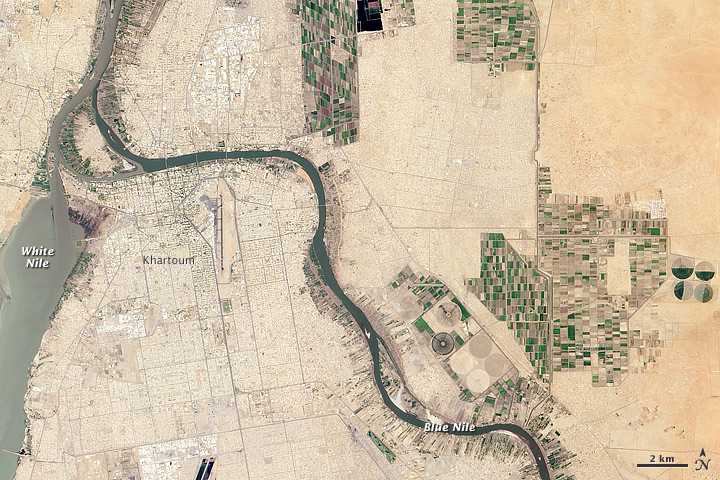NASA: Sudan - Khartoum - Two Niles Meet - 28.05.13
Posted by Ricardo Marcenaro | Posted in NASA: Sudan - Khartoum - Two Niles Meet - 28.05.13 | Posted on 19:05

acquired April 26, 2013
download large image (4 MB, JPEG, 2929x4000)
acquired April 26, 2013
download GeoTIFF file (22 MB, TIFF)
Though it moves just a tiny fraction
of the water carried by the Amazon, Congo, or Niger rivers, the Nile is
the world’s longest river. Its main tributaries—the White Nile and the
Blue Nile—meet in Khartoum, Sudan, a rain-poor city of nearly 2 million
residents that relies on the Nile for irrigation. Well-watered crops
line the river banks, and patchworks of croplands (including
center-pivot irrigated fields) dot the city’s outskirts.
The Advanced Land Imager (ALI) on NASA’s Earth Observing-1
(EO-1) satellite acquired this natural-color image on April 26, 2013,
near the end of the region’s dry season. Compared to the White Nile, the
Blue Nile is skinny and its highly variable flow is near its lowest
point at this time of year. Harsh dry seasons and droughts can
periodically dry out the Blue Nile completely.
The White Nile and Blue Nile derive their colors from the sediments
they carry. Originating in the Equatorial Lakes region, the White Nile
is rich in light gray sediments. As this long river meanders over flat
terrain, it loses over half of its water to evaporation.
Shorter than the White Nile, the Blue Nile starts in the highlands of
Ethiopia and Eritrea, picking up black sediment en route to Khartoum.
The Blue Nile is fed by monsoon rains, and when rains are abundant, the
Blue Nile can actually flow backward near its confluence with the White
Nile.
Upstream from both rivers, residents rely largely on precipitation
for farming. Most of the water extraction along the Nile occurs in Sudan
and Egypt, where rainfall is too sparse to support crops. More than 120
millio people rely upon Nile waters for irrigation and other uses.
References
- Trade and Environment Database (1997, November) Blue Nile. Accessed May 9, 2013.
- UNESCO (2008, January) Sediment in the Nile River System. Accessed May 9, 2013.
NASA Earth Observatory image by Jesse Allen and Robert Simmon, using EO-1 ALI data from the NASA EO-1 team. Caption by Michon Scott.
- Instrument:
- EO-1 - ALI
NASA: Sudan - Khartoum - Two Niles Meet - 28.05.13
Ricardo M Marcenaro - Facebook
Blogs in operation of The Solitary Dog:
Solitary Dog Sculptor: byricardomarcenaro.blogspot.com
Solitary Dog Sculptor I: byricardomarcenaroi.blogspot.com/
Para:
comunicarse conmigo,
enviar materiales para publicar,
propuestas comerciales:
comunicarse conmigo,
enviar materiales para publicar,
propuestas comerciales:
marcenaroescultor@gmail.com
For:
contact me,
submit materials for publication,
commercial proposals:
For:
contact me,
submit materials for publication,
commercial proposals:
marcenaroescultor@gmail.com
My blogs are an open house to all cultures, religions and countries. Be a follower if you like it, with this action you are building a new culture of tolerance, open mind and heart for peace, love and human respect. Thanks :)
Mis blogs son una casa abierta a todas las culturas, religiones y países. Se un seguidor si quieres, con esta acción usted está construyendo una nueva cultura de la tolerancia, la mente y el corazón abiertos para la paz, el amor y el respeto humano. Gracias:)
(::)


Comments (0)
Publicar un comentario